Dopravní značky na Novém Zélandu - Road signs in New Zealand
Dopravní značky na Novém Zélandu jsou podobné těm, které stanoví Vídeňská úmluva o dopravních značkách a signálech. Zatímco Nový Zéland není signatářem úmluvy, je to jeho dopravní značky mají obecně blízký tvar a funkci. Nový Zéland používá pro varování společné znaky ve tvaru žlutého kosočtverce Austrálie, Severní a Jižní Amerika, Irsko, Japonsko a Thajsko. Značky omezení rychlosti jsou červený kruh s bílým pozadím a omezením černé a jsou v kilometrech za hodinu. Na Novém Zélandu jsou také některé značky. Dopravní značky na Novém Zélandu jsou řízeny Dopravní agentura NZ a jsou předepsány v pravidle pozemní dopravy: Zařízení pro řízení dopravy z roku 2004 a stanoveny v Příručka k zařízením pro řízení dopravy (TCD).[1]
Většina z těchto značek byla zavedena až v roce 1987 a nahradila značky staršího stylu bílým textem na černém pozadí - čtverec s červeným okrajem pro regulační značky a diamant se žlutým okrajem. Jediné znaky, které zůstaly stejné, byly značka Stop a značka omezení rychlosti (ačkoli legenda „km / h“ z metrication byla odstraněna). Některé z těchto značek lze stále vidět na některých venkovských silnicích.
Nový Zéland pohony vlevo.
Regulační
Rychlostní limity jsou uváděny v násobcích 10 kilometrů za hodinu [km / h] (6,2 mph) a pohybují se v rozmezí 10–110 km / h (6–68 mph), přičemž maximální povolená rychlost pro motorová vozidla je 110 km / h. na Novém Zélandu. The Manuál dopravních značek a značení specifikuje to poradní rychlosti (PW-25) vždy končí číslicí „5“, existují však poradní značky rychlosti, které nejsou v souladu s Manuál a končí nulou.[2]

(R1-1) Rychlostní limit 10 km / h
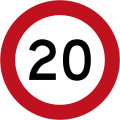
(R1-1) Rychlostní limit 20 km / h

(R1-1) Rychlostní limit 30 km / h
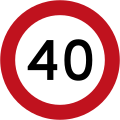
(R1-1) Rychlostní limit 40 km / h

(R1-1) Rychlostní limit 50 km / h

(R1-1) Rychlostní limit 60 km / h

(R1-1) Rychlostní limit 70 km / h

(R1-1) Rychlostní limit 80 km / h

(R1-1) Rychlostní limit 90 km / h

(R1 - 1,1) Rychlostní limit 100 km / h

(R1 - 1,2) Rychlostní limit 110 km / h
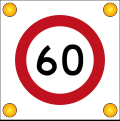
(R1-2) Variabilní rychlostní limit 60 km / h
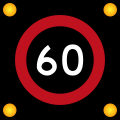
(R1-2,1) Variabilní rychlostní limit 60 km / h

(R1-3) Omezení rychlosti (žádné zveřejněné omezení rychlosti, platí maximálně 100 km / h, ale jeďte za podmínek)

(R1-6) Při blikání platí rychlostní limit 40 km / h pro školní zónu

(R1-6,1) Ve stanovených časech platí omezení rychlosti školní zóny na 40 km / h

(R1-8) Dočasné znamení (přidáno ke značkám omezení rychlosti, které označují, že omezení je pouze dočasné)

(R1-8,1) Dočasné znamení (přidáno ke značkám omezení rychlosti, které označují, že omezení je pouze dočasné)
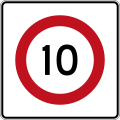
(R1-8,1) Rychlostní limit 10 km / h

(R1-8,1) Rychlostní limit 20 km / h

(R1-8,1) Rychlostní limit 30 km / h
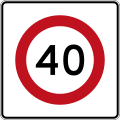
(R1-8,1) Rychlostní limit 40 km / h

(R1-8,1) Rychlostní limit 50 km / h
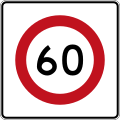
(R1-8,1) Rychlostní limit 60 km / h

(R1-8,1) Rychlostní limit 70 km / h

(R1-8,1) Rychlostní limit 80 km / h

(R1-8,1) Rychlostní limit 90 km / h

(R2-1) Stop

(R2-2) Dát přednost

(R2-2) Fluorescenční verze

(R2-2,2) Přímý provoz (přidáno do R2-2)

(R2-2,3) Doprava odbočující doprava (přidáno do R2-2)

(R2-2,4) Doprava odbočující doleva (přidáno do R2-2)

(R2-2,5) Cyklistům (přidáno do R2-2)

(R2-2,6) Cyklistům a chodcům (přidáno do R2-2)
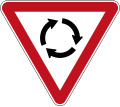
(R2-3) Uvolněte cestu v Kruhový objezd (dát přednost vozidlům přicházejícím zprava)

(R2-3) Fluorescenční verze

(R2-4) Zastavení školní hlídky (používá křížení strážců když děti přecházejí přes ulici, musí vozidla zastavit)

(R2-4) Perforovaná verze
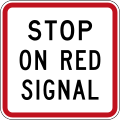
(R2-6) Zastavte na červeném signálu

(R2-6,2) Zastavte se zde na červeném signálu

(R2-7) Dejte přednost protijedoucím vozidlům (používá se v místech s úzkým hrdlem provozu)

(R2-7,1) Dát přednost (added to R2-7) (used at traffic bottleneck points)

(R2-8) Přednost před protijedoucími vozidly (používá se v místech s úzkým hrdlem provozu)

(R2-9) Otáčení dopravy ustupuje chodcům

(R2-9,1) Otáčení provozu ustupuje cyklistům

(R2-9,2) Přímý provoz ustoupí cyklistům

(R2-10) Jedno vozidlo na zelenou v každém jízdním pruhu

(R3-1) Žádná odbočka doleva

(R3-2) Žádná odbočka vpravo

(R3-3) Ne, ty jsi na řadě

(R3-4) Vstup zakázán (nevstupujte od tohoto bodu)

(R3-5.1) Kromě autobusů

(R3-5.2) Kromě cyklů

(R3-5.1) Kromě autorizovaných vozidel
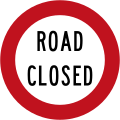
(R3-6) Silnice uzavřena

(R3-7) Špatným směrem

(R3-7.1) Wrong Way - Go Back

(R3-8) Odbočit vlevo

(R3-9) Pokračujte rovně (žádné zatáčky nejsou povoleny)

(R3-10) Odbočit vpravo

(R3-11) Odbočte doleva nebo doprava

(R3-12) Jednosměrný provoz (ukazuje doleva)

(R3-12) Jednosměrný provoz (směřující doprava)

(R3-13) Držet se vlevo

(R3-13.1) Držet se vlevo (úzká verze)

(R3-13.2) Drž se vpravo

(R3-13.3) Drž se vpravo (úzká verze)

(R4-1) Tento pruh musí odbočit doleva
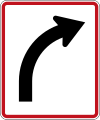
(R4-1) Tato dráha musí odbočit vpravo

(R4-2) Tato dráha musí postupovat rovně

(R4-3) Tento pruh může postupovat rovně nebo odbočit vlevo

(R4-3) Tento pruh může postupovat rovně nebo odbočit vpravo
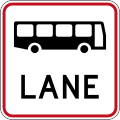
(R4-7) Pruh pro autobusy

(R4-7.1) Pouze autobusy

(R4-8,4) Tranzitní pruh končí

(R4-8,4) Tranzitní pruh končí
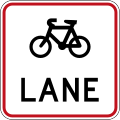
(R4-9) Cyklista Lane

(R4-9.1) Pouze cyklisté

(R4-10) Lane těžkých vozidel

(R4-11) Sdílené cyklisty a chodce

(R4-11.1) Cyklisté a chodci udržují strany

(R4-11.2) Cyklisté a chodci udržují strany

(R4-12) Pouze nouzový brzdný pruh

(R4-12.1) Dráha pro nouzové zastavení Pouze během stanovených časů

(R4-12.2) Lane nouzového zastavení

(R4-13) Přechodový pruh obchvatu signálu pro vozidla přepravující 2 nebo více osob a těžká vozidla přesahující 3 500 kilogramů

(R4-13) Přechodový pruh obchvatu signálu pro vozidla přepravující 3 nebo více osob a těžká vozidla přesahující 3 500 kilogramů

(R4-13.1) Přechodový pruh obchvatu signálu pro vozidla přepravující 2 nebo více osob a těžká vozidla přesahující 3 500 kilogramů

(R4-13.1) Přechodový pruh obchvatu signálu pro vozidla přepravující 3 nebo více osob a těžká vozidla přesahující 3 500 kilogramů

(R4-13.2) Nezastavujte kvůli signálům

(R4-13.3a) Signály neplatí

(R4-13.3b) Signály neplatí

(R4-14) Dráha autobusu a elektrického vozidla

(R4-14.1) Pouze autobusy a elektrická vozidla

(R4-14.2) Tranzitní pruh pro vozidla přepravující 2 nebo více osob a elektrická vozidla bez ohledu na počet osob ve vozidle

(R4-14,3) Tranzitní pruh pro vozidla přepravující 3 nebo více osob a elektrická vozidla bez ohledu na počet osob ve vozidle

(R4-14,4) Tranzitní pruh pro vozidla přepravující 2 nebo více osob, těžká vozidla přesahující 3 500 kilogramů a elektrická vozidla bez ohledu na počet osob ve vozidle

(R4-14,5) Tranzitní pruh pro vozidla přepravující 3 nebo více osob, těžká vozidla přesahující 3 500 kilogramů a elektrická vozidla bez ohledu na počet osob ve vozidle
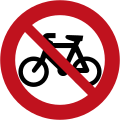
(R5-1) Žádní cyklisté nebo mopedy
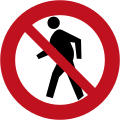
(R5-2) Žádní chodci

(R5-3) Žádná těžká vozidla
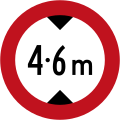
(R5-4.1) Maximální omezení výšky
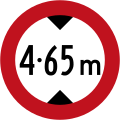
(R5-4.2) Maximální omezení výšky

(R5-5) Pouze chodci (označuje pěší zónu, kde jsou zakázána motorová vozidla)

(R5-6) Cykly musí opustit

(R5-7) Silnice třídy C. (Těžká vozidla mohou po této silnici jezdit pouze za účelem dodání nebo vyzvednutí zboží nebo cestujících po silnici)

(R5-7.1) Silnice I. třídy

(R5-7.2) Silnice I. třídy do stanoveného data

(R5-8) Maximální délka pro těžká vozidla

(R5-10) Limit hmotnosti nápravy těžkého vozidla
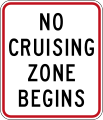
(R5-13A) Žádná cestovní zóna

(R5-13.1A) Nezačíná žádná cestovní oblast

(R5-13,2A) Žádná cestovní zóna nekončí

(R7-1) Držte se vlevo, pokud neprojíždíte

(R7-1) Držte se vlevo, pokud neprojíždíte

(R7-1) Držte se vlevo, pokud neprojíždíte
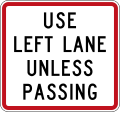
(R7-1,1) Pokud neprochází, použijte levý pruh

(R7-2) Regulační značka účinná dopředu

(R7-2.1) Účinné regulační znamení začíná

(R7-2.2) Účinné končí regulační znamení

(R7-2.1) Regulační značka účinná do 100 metrů

(R7-2.2) Regulační značka účinná do 200 metrů

(R7-2.3) Regulační značka účinná do 300 metrů
Parkoviště

(R6-10.1) Nezastavovat

(R6-10.1) Nezastavovat (nalevo od této značky)

(R6-10.1) Nezastavovat (napravo od této značky)

(R6-10.1) Nezastavovat (na obou stranách tohoto označení)

(RP-1.1) Nezastavovat (nalevo od této značky)

(RP-1.1) Nezastavovat (napravo od této značky)

(RP-1.1) Nezastavovat (na obou stranách tohoto označení)

(R6-10.2) Zákaz zastavení na 1 kilometr

(R6-10.2) Zákaz zastavení na 2 kilometry

(R6-10.2) Zákaz zastavení na 3 kilometry

(R6-10.2) Zákaz zastavení na 4 kilometry

(R6-10.2) Zákaz zastavení na 5 kilometrů

(R6-11) Předčasně není zastaveno (nalevo od této značky)

(R6-11) Zákaz předčasného zastavení (napravo od této značky)

(R6-11) Zákaz předčasného zastavení (na obou stranách tohoto označení)

(R6-11.1) Prodloužení pozdní noci (přidáno do R6-11)

(R6-12.1) Předpolí (zákaz zastavení) (s jediným špičkovým časem)
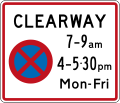
(R6-12.2) Předpolí (zákaz zastavení) (se dvěma špičkami)
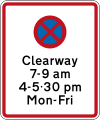
(R6-12.3) Předpolí (bez zastavení) během zadaných časů

(R6-12.4) Clearway začíná

(R6-12,5) Clearway končí
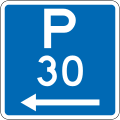
(R6-30) Parkování povoleno: 30 minut (vlevo od tohoto označení, standardní hodiny)

(R6-30) Parkování povoleno: 30 minut (napravo od tohoto označení, standardní hodiny)
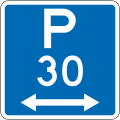
(R6-30) Parkování povoleno: 30 minut (na obou stranách tohoto označení, standardní hodiny)
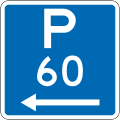
(R6-30) Parkování povoleno: 60 minut (vlevo od tohoto označení, standardní hodiny)

(R6-30) Parkování povoleno: 60 minut (napravo od tohoto označení, standardní hodiny)

(R6-30) Parkování povoleno: 60 minut (na obou stranách tohoto označení, standardní hodiny)

(R6-30) Parkování povoleno: 120 minut (vlevo od tohoto označení, standardní hodiny)

(R6-30) Parkování povoleno: 120 minut (napravo od tohoto označení, standardní hodiny)

(R6-30) Parkování povoleno: 120 minut (na obou stranách tohoto označení, standardní hodiny)

(R6-30.1) Prodloužení pozdní noci

(R6-31) Parkování povoleno: 30 minut (nalevo od tohoto označení nestandardní hodiny)

(R6-31) Parkování povoleno: 30 minut (napravo od této značky nestandardní hodiny)

(R6-31) Parkování povoleno: 30 minut (na obou stranách tohoto označení, nestandardní hodiny)

(R6-32) Parkování povoleno: 30 minut (vlevo od tohoto znamení, jindy)
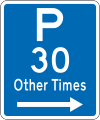
(R6-32) Parkování povoleno: 30 minut (napravo od tohoto označení, jindy)

(R6-32) Parkování povoleno: 30 minut (na obou stranách tohoto označení, jindy)

(R6-50.1) Pouze dobrá vozidla

(R6-50.2) Maximálně 5 minut, pouze nákladní vozidla

(R6-50,5) Načítání parkovacích zón: 5 minut
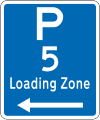
(R6-50,5) Načítání parkovacích zón: 5 minut (nalevo od této značky)

(R6-50,5) Načítání parkovacích zón: 5 minut (napravo od této značky)

(R6-50,5) Načítání parkovacích zón: 5 minut (na obou stranách tohoto označení)

(R6-51) Parkování motocyklů

(R6-51.1) Parkování motocyklů (nalevo od této značky)

(R6-51.1) Parkování motocyklů (napravo od této značky)
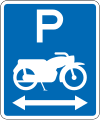
(R6-51.1) Parkování motocyklů (na obou stranách tohoto označení)

(R6-52) Parkování cyklistů
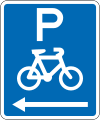
(R6-52.1) Parkování cyklistů (nalevo od této značky)
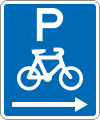
(R6-52.1) Parkování cyklistů (napravo od této značky)

(R6-52.1) Parkování cyklistů (na obou stranách tohoto označení)

(R6-53) Parkování autobusů: Bez omezení

(R6-53,1) Parkování autobusů: Bez omezení (nalevo od této značky)

(R6-53,1) Parkování autobusů: Bez omezení (napravo od této značky)

(R6-53,1) Parkování autobusů: Bez omezení (na obou stranách tohoto označení)

(R6-53.2.1) Parkování autobusů: časový limit

(R6-53.2.1) Parkování autobusů: časový limit (nalevo od této značky)

(R6-53.2.1) Parkování autobusů: časový limit (napravo od této značky)

(R6-53.2.1) Parkování autobusů: časový limit (na obou stranách tohoto označení)

(R6-53.2.2) Parkování autobusů: nestandardní hodiny (nalevo od této značky)

(R6-53.2.2) Parkování autobusů: nestandardní hodiny (napravo od této značky)

„(R6-53.2.2) Parkování autobusů: nestandardní hodiny (na obou stranách tohoto označení)

(R6-53,3) Tour Coaches Only

(R6-54) Parkování kyvadlové dopravy: Bez omezení

(R6-54,1) Parkování kyvadlové dopravy: Bez omezení (nalevo od této značky)

(R6-54.1) Parkování kyvadlové dopravy: Bez omezení (napravo od této značky)
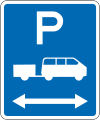
(R6-54.1) Parkování kyvadlové dopravy: Bez omezení (na obou stranách tohoto označení)

(R6-54.2) Kyvadlové parkování: časový limit

(R6-54.2) Kyvadlové parkování: časový limit (nalevo od této značky)

(R6-54.2) Kyvadlové parkování: časový limit (napravo od této značky)

(R6-54.2) Kyvadlové parkování: časový limit (na obou stranách tohoto označení)

(R6-55) Zakázané parkování: Bez omezení

(R6-55,1) Zakázané parkování: Bez omezení (nalevo od této značky)
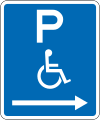
(R6-55,1) Zakázané parkování: Bez omezení (napravo od této značky)

(R6-55,1) Zakázané parkování: Bez omezení (na obou stranách tohoto označení)

(R6-55,2) Zakázané parkování: časový limit

(R6-55,2) Zakázané parkování: časový limit (nalevo od této značky)

(R6-55,2) Zakázané parkování: časový limit (napravo od této značky)

(R6-55,2) Zakázané parkování: časový limit (na obou stranách tohoto označení)
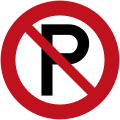
(R6-70) Zákaz parkování

(R6-71) Zákaz parkování: autobusová zastávka

(R6-71,1) Zákaz parkování: autobusová zastávka (nalevo od této značky)

(R6-71,1) Zákaz parkování: autobusová zastávka (napravo od této značky)

(R6-71,1) Zákaz parkování: autobusová zastávka (na obou stranách tohoto označení)

(R6-71B) Zákaz parkování: autobusová zastávka

(R6-71.1B) Zákaz parkování: autobusová zastávka (nalevo od této značky)

(R6-71.1B) Zákaz parkování: autobusová zastávka (napravo od této značky)

(R6-71.1B) Zákaz parkování: autobusová zastávka (na obou stranách tohoto označení)

(R6-72.2) Zákaz parkování: Autobusová zastávka

(R6-72.2) Zákaz parkování: Autobusová zastávka (nalevo od této značky)

(R6-72.2) Zákaz parkování: Autobusová zastávka (napravo od této značky)

(R6-72.2) Zákaz parkování: Autobusová zastávka (na obou stranách tohoto označení)
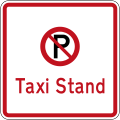
(R6-72) Zákaz parkování: Stanoviště taxi

(R6-72.1) Zákaz parkování: Stanoviště taxi (nalevo od této značky)
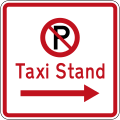
(R6-72.1) Zákaz parkování: Stanoviště taxi (napravo od této značky)

(R6-72.1) Zákaz parkování: Stanoviště taxi (na obou stranách tohoto označení)

(R6-73) Zákaz parkování: Shuttle Stop

(R6-73,1) Zákaz parkování: Shuttle Stop (nalevo od této značky)

(R6-73,1) Zákaz parkování: Shuttle Stop (napravo od této značky)

(R6-73,1) Zákaz parkování: Shuttle Stop (na obou stranách tohoto označení)

(R6-74) Zákaz parkování: Tramvajová zastávka

(R6-74,1) Zákaz parkování: Tramvajová zastávka (nalevo od této značky)

(R6-74,1) Zákaz parkování: Tramvajová zastávka (napravo od této značky)

(R6-74,1) Zákaz parkování: Tramvajová zastávka (na obou stranách tohoto označení)

(R6-79) Zákaz parkování: Nouzové zastavení vozidla

(R6-79,1) Zákaz parkování: Nouzové zastavení vozidla (nalevo od této značky)

(R6-79,1) Zákaz parkování: Nouzové zastavení vozidla (napravo od této značky)

(R6-79,1) Zákaz parkování: Nouzové zastavení vozidla (na obou stranách tohoto označení)

(RP-3,4) Předpolí během předepsaných dnů

(RP-11) Zóna parkování kupónů začíná

(RP-11) Zóna parkování kupónů končí

(RP-12) Parkovací zóna kupónu (znak opakovače)

Parkování s placením a zobrazováním

Vozidla s osvobozením od povolení

Parkování pouze pro autorizovaná vozidla
Obecné poradenství

(A40-1) Žádný východ

(A40-2) Odbočte kdykoli opatrně

(A40-3) Výstražné zvony na železničním přejezdu byly vypnuty (občas předepsáno)

(A41-3) Staveniště (doleva)

(A41-3) Staveniště (doprava)

(A41-4) Železnice se nepoužívá

(IG-4) Těžké vozidlo projíždí vpřed (ve 200 metrech)
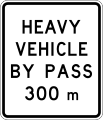
(IG-4) Těžké vozidlo předjíždí (ve 300 metrech)

(IG-5) Obtížné vozidlo (vlevo)
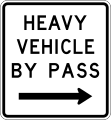
(IG-5) Obtížné vozidlo (napravo)
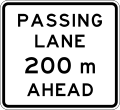
(IG-6) Projíždíme Lane Ahead (ve 200 metrech)

(IG-6) Projíždíme Lane Ahead (ve 300 metrech)
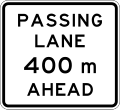
(IG-6) Projíždíme Lane Ahead (ve 400 metrech)

(IG-6.1) Projíždíme Lane Ahead (na 1 kilometru)
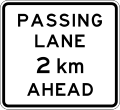
(IG-6.1) Projíždíme Lane Ahead (ve 2 kilometrech)
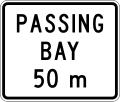
(IG-7) Před námi Bay (v 50 metrech)

(IG-7) Před námi Bay (ve 100 metrech)

(IG-7) Před námi Bay (ve 150 metrech)

(IG-7) Před námi Bay (ve 200 metrech)

(IG-7) Před námi Bay (ve 300 metrech)

(IG-8) Pomalé zátoky vozidla (na další 2 kilometry)

(IG-8) Pomalé zátoky vozidla (na dalších 5 kilometrů)
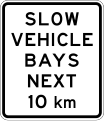
(IG-8) Pomalé zátoky vozidla (na dalších 10 kilometrů)

(IG-9) Pomalu vpředu (ve 300 metrech)
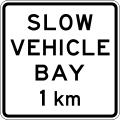
(IG-9) Pozice vpředu pomalého vozidla (na 1 kilometru)

(IG-9) Pozice vpředu pomalého vozidla (ve 2 kilometrech)

(IG-10) Pozice pro pomalé vozidlo (ukazatel)

(IG-17) Těžká vozidla Nepoužívejte brzdy motoru (na další 4 kilometry)

(IG-18) Před likvidací odpadních vod (vlevo, 300 metrů)
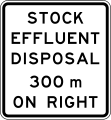
(IG-18) Před likvidací odpadních vod (vpravo, do 300 metrů)
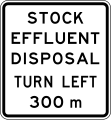
(IG-18) Před likvidací odpadních vod (odbočka doleva, 300 metrů)

(IG-18) Před likvidací odpadních vod (odbočka vpravo, do 300 metrů)
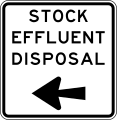
(IG-19) Místo likvidace odpadních vod (odbočit vlevo)

(IG-19) Místo likvidace odpadních vod (odbočit vpravo)
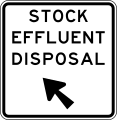
(IG-19) Místo likvidace odpadních vod (otočit se vlevo)

(IG-19) Místo likvidace odpadních vod (zatočte správně)
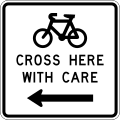
Cyklisté sem přecházejí opatrně (doleva)

Cyklisté sem přecházejí opatrně (doprava)

Cyklisté používají levé rameno

Cyklisté používají rampu
Varování
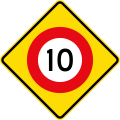
Rychlostní limit 10 km / h dopředu
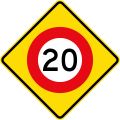
Rychlostní limit 20 km / h dopředu

Rychlostní limit 30 km / h dopředu

Rychlostní limit 40 km / h dopředu

(W10-3) Rychlostní limit 50 km / h dopředu
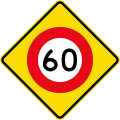
Rychlostní limit 60 km / h dopředu
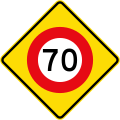
Rychlostní limit 70 km / h dopředu
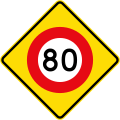
Rychlostní limit 80 km / h dopředu
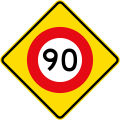
Rychlostní limit 90 km / h dopředu

Nad značkou efektivní 50 metrů vpřed

Nad značkou efektivní 100 metrů vpřed

Nad značkou efektivní 150 metrů vpřed

Nad značkou efektivní 200 metrů vpřed
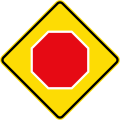
(W10-1 / PW-1) Zastavte dopředu

(W10-2 / PW-2) Dej přednost

(W10-4 / PW-3) Semafory vpředu

(W11-6.1 / PW-4) Sloučení provozu zleva

(PW-4) Sloučení provozu zprava

Sloučení provozu z obou stran
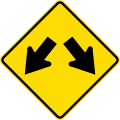
(W14-1 / PW-5) Silnice se rozchází (rozdělí se)
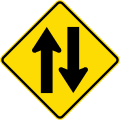
(W14-2 / PW-6) Obousměrný provoz vpřed

(W11-7) Zvýšení pruhu vlevo

(W11-7) Zisk pruhu vpravo

(W11-1 / (PW-8) Kruhový objezd vpřed

(PW-9) Prioritní silnice rovně

(PW-9.1) Prioritní silnice zahne doleva

(W11-2.1 / PW-9.1) Prioritní silnice zahne doprava

(PW-10) Řízený T-spoj (priorita odbočí doleva)

(PW-10) Řízený T-spoj (priorita se otočí doprava)

(PW-10.1) Nekontrolovaný T-spoj

(PW-11) Řízená boční křižovatka vlevo

(PW-11) Řízená boční křižovatka vpravo

(PW-11.1) Nekontrolovaná křižovatka na vedlejší silnici vlevo

(PW-11.1) Nekontrolovaná boční křižovatka vpravo

(PW-12) Řízený Y-spoj vpravo

(PW-12) Řízená křižovatka Y vlevo

(PW-12.1) Nekontrolovaná Y-křižovatka

(PW-13a) Železniční přejezd po vedlejší silnici vlevo

(PW-13a) Železniční přejezd po vedlejší silnici vpravo

(PW-13b) Železniční přejezd po vedlejší silnici vlevo

(PW-13b) Železniční přejezd po vedlejší silnici vpravo

(PW-13.1) Železniční přejezd po vedlejší silnici vlevo

(PW-13.1) Železniční přejezd po vedlejší silnici vpravo

(PW-13.2) Železniční přejezd na řízeném křižovatce T doleva

(PW-13.2) Železniční přejezd na řízeném křižovatce T doprava

(PW-13.3) Železniční přejezd na neřízené křižovatce T doleva

(PW-13.3) Železniční přejezd na neřízené křižovatce T doprava

(PW-14) Železnice Crossbuck

(W15-3.1 / PW-14b) Železnice Crossbuck (s červenou podkladovou deskou)

(PW-16) 90 stupňová křivka vlevo

(PW-16) 90 stupňová křivka, doprava

(PW-17) Křivka mezi 15 a 90 stupni doleva

(PW-17) Křivka mezi 15 a 90 stupni, doprava

(PW-18) Ostrá křivka mezi 90 a 120 stupni doleva

(W12-1,3 / PW-18) Ostrá křivka mezi 90 a 120 stupni, doprava

(PW-19) Nebezpečná křivka větší než 120 stupňů, doleva

(PW-19) Nebezpečná křivka větší než 120 stupňů, doprava

(PW-20) Obrátit křivku o méně než 60 stupňů doleva

(PW-20) Obrátit křivku o méně než 60 stupňů, doprava

(PW-21) Obrátit křivku o více než 60 stupňů doleva

(PW-21) Obrátit křivku větší než 60 stupňů, doprava

(PW-22) Obrátit křivku se zmenšujícím se poloměrem doleva

(PW-22) Obrátit křivku se zmenšujícím se poloměrem doprava

(PW-23) Série křivek vpřed, první doleva

(PW-23) Série křivek vpřed, první doprava

(PW-24) Znamení účinné na další 2 kilometry

(PW-24) Znamení účinné na další 3 kilometry

(PW-24) Znamení účinné na další 4 kilometry

(PW-24) Znamení účinné na dalších 5 kilometrů

(PW-24) Znamení efektivní na dalších 6 kilometrů

(PW-24) Znamení účinné na dalších 7 kilometrů

(PW-24) Znamení účinné na dalších 8 kilometrů

(PW-24) Znamení účinné na dalších 9 kilometrů

(PW-24) Znamení účinné na dalších 10 kilometrů

(PW-24) Znamení účinné na dalších 15 kilometrů

(PW-24) Znamení platí pro příštích 20 kilometrů

(PW-24) Znamení efektivní na dalších 25 kilometrů

(PW-25) Doporučená rychlost: 15 km / h

(PW-25) Doporučená rychlost: 25 km / h

(PW-25) Doporučená rychlost: 35 km / h

(PW-25) Doporučená rychlost: 45 km / h

(PW-25) Doporučená rychlost: 55 km / h

(PW-25) Doporučená rychlost: 65 km / h

(PW-25) Doporučená rychlost: 75 km / h

(PW-25) Doporučená rychlost: 85 km / h

(PW-25) Doporučená rychlost: 95 km / h

(PW-26) Křivka mezi 15 a 90 stupni s vedlejší silnicí vlevo

(PW-26) Křivka mezi 15 a 90 stupni s vedlejší silnicí vpravo
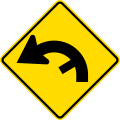
(PW-26) Křivka mezi 90 a 120 stupni s vedlejší silnicí vlevo

(PW-26) Křivka mezi 90 a 120 stupni s vedlejší silnicí vpravo

(PW-26) Skryté

Poradní rychlost pro nákladní vozidla (nebezpečí překlopení při překročení rychlosti)

Poradní rychlost pro nákladní vozidla (nebezpečí překlopení při překročení rychlosti)
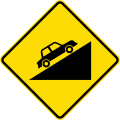
(W14-10.1 / PW-27) Strmý sestup

(W14-9,1 / PW-27) Strmý výstup

Strmý sestup (se známkou)

Strmý výstup (se známkou)

Použijte nižší rychlostní stupeň
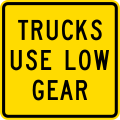
(PW-28) Nákladní automobily používají nižší rychlostní stupeň
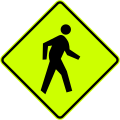
(PW-29) Dávejte pozor na přechod chodců

(PW-29.1) Dávejte pozor na staré chodce
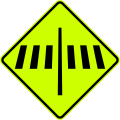
(PW-30) Přechod pro chodce vpřed

(W16-4 / PW-31) Dávejte pozor na přechody dětí

(PW-31.1) Zóna mateřské školy

(PW-32) Škola
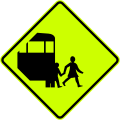
(PW-34) Dávejte pozor na školní autobusy

(PW-34.1) Trasa školního autobusu

(PW-34.2) Oblast otáčení školního autobusu

(PW-35) Dávejte pozor na cyklisty

(PW-36) Dávejte pozor na koně (Používá se ve Ferrymead)

(W18-3.1) Dávejte pozor na zvířata (dobytek)

(W18-3.2) Dávejte pozor na zvířata (ovce)

(W18-3.3) Dávejte pozor na zvířata (Jelen)
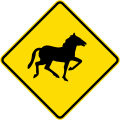
(W18-3,4) Dávejte pozor na zvířata (divocí koně)

(W18-3,8) Dávejte pozor na zvířata (tučňáci)

(W18-3,9) Dávejte pozor na zvířata (kiwi)

(W14-3 / PW-38) Silniční pokles

(W14-4 / PW-39) Silniční boule

(PW-40) Nerovná cesta

(PW-41) Kluzká silnice

(PW-41.1) Silnice kluzká, když je mráz

(PW-41.2) Silnice na mokré vozovce

(PW-41.3) Silnice má kluzký štěrkový povrch

Volný povrch vozovky (nebezpečí rozrušení)

(W14-6 / PW-42) Padající kameny nebo trosky nalevo

(PW-42) Padající kameny nebo trosky vpravo

(PW-43) Silnice se vlevo zužuje

(PW-43) Cesta se vpravo zužuje

(PW-43.1) Silnice se z obou stran zužuje

(PW-44) Úzký most

(PW-44.1) Úzký most, široká vozidla jsou opatrní

(PW-45) Maximální světlá výška dopředu

(PW-46) Značka maximální výšky

(PW-47) Nadzemní elektrické kabely
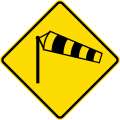
(PW-48) Nebezpečí silných poryvů větru

(PW-49) Požární stanice

(PW-50) Dávejte pozor na nákladní automobily

(PW-50.1) Dávejte pozor na vysokozdvižné vozíky a další pracovní vozidla
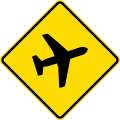
(PW-51) Nízko letící letadlo

(PW-51.1) Nízko letící vrtulníky

(PW-52) Tunel dopředu
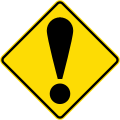
(PW-53) Pozor: Další nebezpečí! (nikdy se nepoužívá samostatně, nebezpečí vysvětlí doplňkový štítek)

(PW-54) Brod

(PW-55) Dobytek se zastaví

(PW-56) Brána

(PW-57) Před sebou nekontrolované železniční přejezd

(PW-57) Před sebou nekontrolované železniční přejezd

(PW-58) Řízené železniční přejezd vpřed se signály a branami
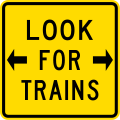
(PW-59) Před přejezdem hledejte vlaky oběma směry

Cyklisté se starají o železniční tratě

(PW-60) Železniční přejezd vpřed v pravém úhlu

(PW-60.1) Železniční přejezd vpřed v šikmém úhlu

(PW-60.2) Železniční přejezd vpřed v šikmém úhlu

(PW-63) Lehký železniční přejezd

(PW-63) Železniční přejezd

Připravte se zastavit dopředu

Skrytá fronta vpřed

Ve frontě vozidla vpředu

(PW-65) Maják Belisha

(PW-66) Značka oblouku s integrovanou poradní rychlostí

(PW-66) Značka oblouku s integrovanou poradní rychlostí

(PW-66) Značka oblouku s integrovanou poradní rychlostí

(PW-66) Značka oblouku s integrovanou poradní rychlostí

(PW-67) Značka křivky

(PW-67) Značka křivky

Konec značky (používá se na T-křižovatkách)

Konec značky (používá se na T-křižovatkách)

Značka nebezpečí kruhového objezdu
Nasazeno na vozidlo

Signály školního autobusu (oranžová světla budou blikat, když děti nastupují a vystupují)

Školní vozidlo

Školní autobus

Škola

Nebezpečí - zpomalte

Pilotní vozidlo (pro nadrozměrný konvoj)

House Ahead (vpředu konvoj nákladních automobilů)

House následuje (za pilotem následuje náklaďák)

Dlouhé zatížení dopředu (mimořádně dlouhý konvoj vozidla vpředu)

Následuje dlouhé zatížení (za pilotem následuje mimořádně dlouhý konvoj vozidla)

Wide Load Ahead (mimořádně široká konvoje vozidel vpředu)

Následuje široká zátěž (za pilotem následuje mimořádně široká konvoje vozidel)
Dočasné varování

(T1A) Silniční práce

(TW-1.1) Na další 1 kilometr

(TW-1.1) Na další 2 kilometry

(TW-1.1) Na další 3 kilometry

(TW-1.1) Na další 4 kilometry

(TW-1.2.2) Mokrý dehet

(TW-1.3) Grejdr

(TW-1.3) Sekačka

(TW-1.3) Testování smyku

(TW-1.3) Postřikovač plevele

(TW-1.4) Silniční značení

(TW-1,5) Na vedlejší silnici

(TW-1.6) Rameno zavřené

(TW-1,7) Geodetické

(TW-1,8) Opravy mostů

(TW-1B.1.1) Silnice před námi do 1 kilometru

(TW-1B.1.2) Silnice před námi za 2 kilometry

(TW-1B2.1) Pracovníci silnic před námi do 1 kilometru, zpoždění možná

(TW-1B2.2) Pracovníci silnic před námi do 2 kilometrů, možné zpoždění

(TW-1B3 (10) Rychlostní limit vpředu - 10 km / h

(TW-1B3 (20) Rychlostní limit vpředu - 20 km / h

(TW-1B3 (30) Rychlostní limit vpředu - 30 km / h

(TW-1B3 (40) Rychlostní limit vpředu - 40 km / h

(TW-1B3 (50) Rychlostní limit vpředu - 50 km / h

(TW-1B3 (60) Rychlostní limit vpředu - 60 km / h

(TW-1B3 (70) Rychlostní limit vpředu - 70 km / h

(TW-1B3 (80) Rychlostní limit vpředu - 80 km / h

(TW-2) Pozor - další nebezpečí! (nikdy se nepoužívá samostatně, nebezpečí vysvětlí doplňkový štítek)

(TW-2.1) Záplavy

(TW-2.2) Vymytí

(TW-2.3) Traťová posádka

(TW-2.4) Tryskání

(TW-2,5) Kácení stromů

(TW-2.6) Těžba dřeva

(TW-2.7) Křížení nákladních vozidel

(TW-2,8) Žádné dopravní značení

(TW-2,9) Signály změněny

(TW-2.10) Signály nefungují

(TW-2.11) Nové rozložení silnice

(TW-2,12) Dopravní průzkum

(TW-2.13.1) Cyklistický závod

(TW-2.13.2) Běžci

(TW-2.13.3) Chodci

(TW-2,14) Nehoda

(TW-2,15) oheň

(TW-2.16.1) Cyklisté dopředu

(TW-2.16.2) Běžci dopředu

(TW-2.16.3) Walkers Ahead

(TW-2,17) Pohřeb (pohřební průvod)

(TW-2,18) Filmový štáb

Nouzový

(TW-3) Padající kameny nebo trosky nalevo

(TW-3) Padající kameny nebo trosky vpravo

(TW-4) Kluzká silnice

(TW-4.1) Kluzký povrch vozovky v důsledku námrazy nebo písku

(TW-5) Volný povrch vozovky

(TW-5.1) Nová pečeť

(TW-5.2) Opravy těsnění

(TW-6) Dávejte pozor na velká zvířata (dobytek)

(TW-6.1) Dávejte pozor na velká zvířata (ovce)

(TW-7) Znamení účinné 100 metrů vpřed

(TW-7) Znamení účinné 200 metrů vpřed

(TW-7) Znamení účinné 300 metrů vpřed

(TW-7) Znamení účinné 400 metrů vpřed
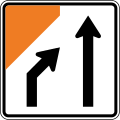
(TW-7) Sloučení pruhu

(TW-7) Správa jízdních pruhů

(TW-7.1) Správa jízdních pruhů
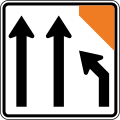
(TW-7.1) Správa jízdních pruhů

(TW-7.1.1) Správa jízdních pruhů

(TW-7.1.1) Správa jízdních pruhů

(TW-7,2 B) Správa jízdních pruhů

(TW-7,2 B) Správa jízdních pruhů
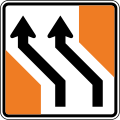
(TW-8) Správa jízdních pruhů

(TW-8) Správa jízdních pruhů

(TW-8.1) Správa jízdních pruhů

(TW-8.1) Správa jízdních pruhů

(TW-9) Správa jízdních pruhů

(TW-10) Správa jízdních pruhů
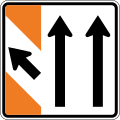
(TW-11) Správa jízdních pruhů

(TW-12) Značka výstupu

(TW-13) Silnice se vlevo zužuje

(TW-13) Cesta se vpravo zužuje
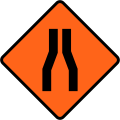
(TW-13.1) Silnice se z obou stran zužuje

(TW-13) Silnice se zužuje do jediného jízdního pruhu

(TW-14) Semafory vpředu

(TW-15) Flagman vpřed

(TW-15) Zastavte prosím na vyžádání (pro vlajkáře)

(TW-16) Práce končí

(TW-17) Děkuji

(TW-19) Osušte brzdy

(TW-20) Silnice před námi uzavřena

(TW-20.1) Výjezd uzavřen dopředu

(TW-21) Objížďka vpřed - sledujte symbol kruhu

(TW-21) Objížďka vpřed - následujte symbol diamantu

(TW-21) Objížďka vpřed - sledujte čtvercový symbol

(TW-21) Objížďka vpřed - sledujte státní dálniční štít

Státní dálniční objížďka vpřed - sledujte státní dálniční štít

(TW-22) Objížďka - sledujte symbol kruhu

(TW-22) Objížďka - sledujte symbol kruhu

(TW-22) Objížďka - sledujte symbol kruhu

(TW-22) Objížďka - sledujte symbol kruhu

(TW-22) Objížďka - sledujte symbol kruhu

(TW-22) Objížďka - sledujte symbol kruhu

(TW-22) Objížďka - následujte symbol diamantu

(TW-22) Objížďka - následujte symbol diamantu

(TW-22) Objížďka - následujte symbol diamantu

(TW-22) Objížďka - následujte symbol diamantu

(TW-22) Objížďka - následujte symbol diamantu

(TW-22) Objížďka - následujte symbol diamantu

(TW-22) Objížďka - následujte čtvercový symbol

(TW-22) Objížďka - následujte čtvercový symbol

(TW-22) Objížďka - následujte čtvercový symbol

(TW-22) Objížďka - následujte čtvercový symbol

(TW-22) Objížďka - následujte čtvercový symbol

(TW-22) Objížďka - následujte čtvercový symbol

(TW-22) Objížďka - sledujte státní dálniční štít

(TW-22) Objížďka - sledujte státní dálniční štít

(TW-22) Objížďka - sledujte státní dálniční štít

(TW-22) Objížďka - sledujte státní dálniční štít

(TW-22) Objížďka - sledujte státní dálniční štít

(TW-22) Objížďka - sledujte státní dálniční štít

(TW-23) Objížďka končí

(TW-24) Cement stříkající - umýt auto dnes

(TW-24.1) Lime Splashes - Wash Car Today

(TW-25) Pilotní auto za mnou

(TW-26) Silniční práce

(TW-27) Silniční inspekce
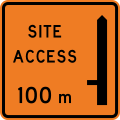
(TW-28) Přístup na staveniště - vlevo 100 metrů dopředu

(TW-28) Přístup na staveniště - vpravo 100 metrů dopředu

(TW-28) Přístup na staveniště - vlevo 200 metrů vpřed

(TW-28) Přístup na staveniště - vpravo 200 metrů dopředu
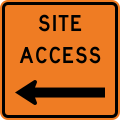
(TW-29) Works přístup na web vlevo
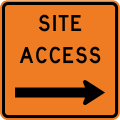
(TW-29) Funguje přístup na stránky vpravo

(TW-30) Přechod uzavřen - použijte alternativní přechod

(TW-31) Footpath closed = - použijte prosím druhou stranu

(TW-32) Cyklisté se řídí tímto znamením

(TW-32) Cyklisté se řídí tímto znamením

(TW-32) Cyklisté se řídí tímto znamením

(TW-32) Cyklisté se řídí tímto znamením

(TW-32) Cyklisté se řídí tímto znamením

(TW-32) Cyklisté se řídí tímto znamením

(TW-32) Chodci se řídí tímto znamením

(TW-32) Chodci se řídí tímto znamením

(TW-32) Chodci se řídí tímto znamením

(TW-32) Chodci se řídí tímto znamením

(TW-32) Chodci se řídí tímto znamením

(TW-32) Chodci se řídí tímto znamením

(TW-34) Projděte opatrně

(TW-35) Silnice se rozchází (rozdělí se)

(TW-36) Nerovnoměrný povrch vozovky

Různé výstražné trojúhelníky
Značky trasy

Státní dálniční značka
Zastaralý

(R1-1) Rychlostní limit 10 km / h

(R1-1) Rychlostní limit 20 km / h
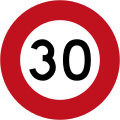
(R1-1) Rychlostní limit 30 km / h
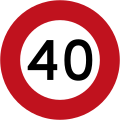
(R1-1) Rychlostní limit 40 km / h

(R1-1) Rychlostní limit 50 km / h

(R1-1) Rychlostní limit 60 km / h

(R1-1) Rychlostní limit 70 km / h

(R1-1) Rychlostní limit 80 km / h
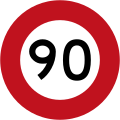
(R1-1) Rychlostní limit 90 km / h

(R1-6,1) Ve stanovených časech platí omezení rychlosti školní zóny na 40 km / h

(R1-8) Dočasné znamení (přidáno ke značkám omezení rychlosti, které označují, že omezení je pouze dočasné)

(R1-8,1) Dočasné znamení (přidáno ke značkám omezení rychlosti, které označují, že omezení je pouze dočasné)

(R1-8,1) Rychlostní limit 10 km / h

(R1-8,1) Rychlostní limit 20 km / h

(R1-8,1) Rychlostní limit 30 km / h

(R1-8,1) Rychlostní limit 40 km / h

(R1-8,1) Rychlostní limit 50 km / h
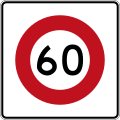
(R1-8,1) Rychlostní limit 60 km / h
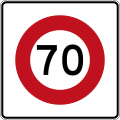
(R1-8,1) Rychlostní limit 70 km / h
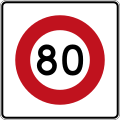
(R1-8,1) Rychlostní limit 80 km / h

(R1-8,1) Rychlostní limit 90 km / h

(R2-1) Stop

Stará verze Give Way (1964-1987)
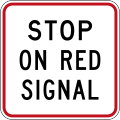
(R2-6) Zastavte na červeném signálu

(2011–2016) Zastavte se zde na červeném signálu

(R2-7,1) Dát přednost (added to R2-7) (used at traffic bottleneck points)
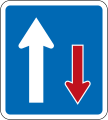
(R2-8) Přednost před protijedoucími vozidly (používá se v místech s úzkým hrdlem provozu)

Stará verze Turning Traffic ustoupit chodcům (19 ?? - 1987)

(R3-1) Žádná odbočka doleva

(R3-2) Žádná odbočka vpravo

(R3-3) Ne, ty jsi na řadě

(R3-5.1) Kromě autobusů

(R3-5.2) Kromě cyklů

(R3-5,3) Kromě autorizovaných vozidel
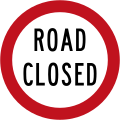
(R3-6) Silnice uzavřena

(R3-7) Špatným směrem

(R3-8) Odbočit vlevo

(R3-9) Pokračujte rovně (není povoleno otáčení)

(R3-10) Odbočit vpravo

(R3-11) Odbočte doleva nebo doprava

(R3-12) Jednosměrný provoz (ukazuje doleva)

(R3-12) Jednosměrný provoz (směřující doprava)

(R3-13) Držet se vlevo

(RG-13.2) Drž se vpravo
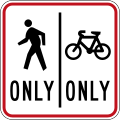
(R4-11.1) Cyklisté a chodci udržují strany

(R4-11.2) Cyklisté a chodci udržují strany

(R4-12) Lane nouzového zastavení

(R5-1) Žádní cyklisté nebo mopedy

(R5-2) Žádní chodci
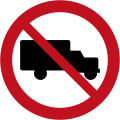
(R5-3) Žádná těžká vozidla

(R5-4.1) Maximální omezení výšky

(R5-4.2) Maximální omezení výšky

(R5-5) Pouze chodci (označuje pěší zónu, kde jsou zakázána motorová vozidla)
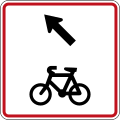
(R5-6) Cykly musí opustit

(R5-8) Maximální délka pro těžká vozidla

(R6-10.1) Nezastavovat (nalevo od této značky)

(R6-10.1) Nezastavovat (napravo od této značky)

(R6-10.1) Nezastavovat (na obou stranách tohoto označení)

(R6-10.1B) Nezastavovat (nalevo od této značky)

(R6-10.1B) Nezastavovat (napravo od této značky)

(R6-10.1B) Nezastavovat (na obou stranách tohoto označení)

(R6-11) Zákaz předčasného zastavení (nalevo od této značky)
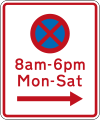
(R6-11) Předčasně není zastaveno (napravo od této značky)
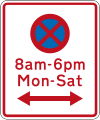
(R6-11) Zákaz předčasného zastavení (na obou stranách tohoto označení)

(R6-11.1) Prodloužení pozdní noci (přidáno do R6-11)

(R6-12.1) Předpolí (zákaz zastavení) (s jediným špičkovým časem)

(R6-12.2) Předpolí (zákaz zastavení) (se dvěma špičkami)

(R6-12.3) Předpolí (bez zastavení) během zadaných časů

(R6-30) Parkování povoleno: 30 minut (vlevo od tohoto označení, standardní hodiny)

(R6-30) Parkování povoleno: 30 minut (napravo od tohoto označení, standardní hodiny)
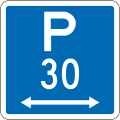
(R6-30) Parkování povoleno: 30 minut (na obou stranách tohoto označení, standardní hodiny)

(R6-30) Parkování povoleno: 60 minut (vlevo od tohoto označení, standardní hodiny)

(R6-30) Parkování povoleno: 60 minut (napravo od tohoto označení, standardní hodiny)

(R6-30) Parkování povoleno: 60 minut (na obou stranách tohoto označení, standardní hodiny)

(R6-30) Parkování povoleno: 120 minut (vlevo od tohoto označení, standardní hodiny)

(R6-30) Parkování povoleno: 120 minut (napravo od tohoto označení, standardní hodiny)

(R6-30) Parkování povoleno: 120 minut (na obou stranách tohoto označení, standardní hodiny)

(R6-31) Parkování povoleno: 30 minut (nalevo od tohoto označení nestandardní hodiny)

(R6-31) Parkování povoleno: 30 minut (napravo od této značky nestandardní hodiny)

(R6-31) Parkování povoleno: 30 minut (na obou stranách této značky, nestandardní hodiny)

(R6-32) Parkování povoleno: 30 minut (jindy vlevo od této značky)

(R6-32) Parkování povoleno: 30 minut (napravo od tohoto označení, jindy)
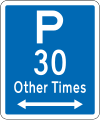
(R6-32) Parkování povoleno: 30 minut (na obou stranách tohoto označení, jindy)

(R6-50.1) Pouze dobrá vozidla

(R6-50.2) Maximálně 5 minut, pouze nákladní vozidla

(R6-50,5) Načítání parkovacích zón: 5 minut
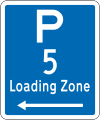
(R6-50,5) Načítání parkovacích zón: 5 minut (nalevo od této značky)

(R6-50,5) Načítání parkovacích zón: 5 minut (napravo od této značky)

(R6-50,5) Načítání parkovacích zón: 5 minut (na obou stranách tohoto označení)

(R6-51) Parkování motocyklů

(R6-51.1) Parkování motocyklů (nalevo od této značky)

(R6-51.1) Parkování motocyklů (napravo od této značky)

(R6-51.1) Parkování motocyklů (na obou stranách tohoto označení)

(R6-52) Parkování cyklistů

(R6-52.1) Parkování cyklistů (nalevo od této značky)
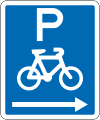
(R6-52.1) Parkování cyklistů (napravo od této značky)

(R6-52.1) Parkování cyklistů (na obou stranách tohoto označení)

(R6-53) Parkování autobusů: Bez omezení
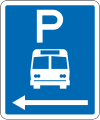
(R6-53,1) Parkování autobusů: Bez omezení (nalevo od této značky)

(R6-53,1) Parkování autobusů: Bez omezení (napravo od této značky)
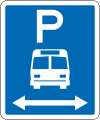
(R6-53,1) Parkování autobusů: Bez omezení (na obou stranách tohoto označení)

(R6-53.2.1) Parkování autobusů: časový limit

(R6-53.2.1) Parkování autobusů: časový limit (nalevo od této značky)

(R6-53.2.1) Parkování autobusů: časový limit (napravo od této značky)

(R6-53.2.1) Parkování autobusů: časový limit (na obou stranách tohoto označení)

(R6-53.2.2) Parkování autobusů: nestandardní hodiny (nalevo od této značky)

(R6-53.2.2) Parkování autobusů: nestandardní hodiny (napravo od této značky)

„(R6-53.2.2) Parkování autobusů: nestandardní hodiny (na obou stranách tohoto označení)

(R6-53,3) Tour Coaches Only

(R6-54) Parkování kyvadlové dopravy: Bez omezení

(R6-54,1) Parkování kyvadlové dopravy: Bez omezení (nalevo od této značky)

(R6-54,1) Parkování kyvadlové dopravy: Bez omezení (napravo od této značky)
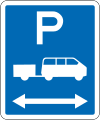
(R6-54,1) Parkování kyvadlové dopravy: Bez omezení (na obou stranách tohoto označení)

(R6-54.2) Kyvadlové parkování: časový limit

(R6-54.2) Kyvadlové parkování: časový limit (nalevo od této značky)

(R6-54.2) Kyvadlové parkování: časový limit (napravo od této značky)

(R6-54.2) Kyvadlové parkování: časový limit (na obou stranách tohoto označení)
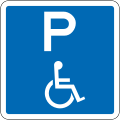
(R6-55) Zakázané parkování: Bez omezení

(R6-55,1) Zakázané parkování: Bez omezení (nalevo od této značky)
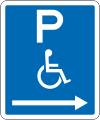
(R6-55,1) Zakázané parkování: Bez omezení (napravo od této značky)

(R6-55,1) Zakázané parkování: Bez omezení (na obou stranách tohoto označení)

(R6-55,2) Zakázané parkování: časový limit

(R6-55.2) Disabled Parking: Time Limit (on the left of this sign)

(R6-55.2) Disabled Parking: Time Limit (on the right of this sign)

(R6-55.2) Disabled Parking: Time Limit (on both sides of this sign)
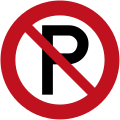
(R6-70) Zákaz parkování

(R6-71) No Parking: Bus Stop

(R6-71.1) No Parking: Bus Stop (on the left of this sign)

(R6-71.1) No Parking: Bus Stop (on the right of this sign)

(R6-71.1) No Parking: Bus Stop (on both sides of this sign)

(R6-71B) No Parking: Bus Stop

(R6-71.1B) No Parking: Bus Stop (on the left of this sign)

(R6-71.1B) No Parking: Bus Stop (on the right of this sign)

(R6-71.1B) No Parking: Bus Stop (on both sides of this sign)

(R6-72.2) No Parking: Coach Stop

(R6-72.2) No Parking: Coach Stop (on the left of this sign)

(R6-72.2) No Parking: Coach Stop (on the right of this sign)

(R6-72.2) No Parking: Coach Stop (on both sides of this sign)

(R6-72) No Parking: Taxi Stand
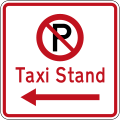
(R6-72.1) No Parking: Taxi Stand (on the left of this sign)

(R6-72.1) No Parking: Taxi Stand (on the right of this sign)
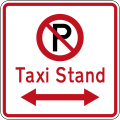
(R6-72.1) No Parking: Taxi Stand (on both sides of this sign)

(R6-73) No Parking: Shuttle Stop

(R6-73.1) No Parking: Shuttle Stop (on the left of this sign)

(R6-73.1) No Parking: Shuttle Stop (on the right of this sign)

(R6-73.1) No Parking: Shuttle Stop (on both sides of this sign)

(R6-74) No Parking: Tram Stop

(R6-74.1) No Parking: Tram Stop (on the left of this sign)

(R6-74.1) No Parking: Tram Stop (on the right of this sign)

(R6-74.1) No Parking: Tram Stop (on both sides of this sign)

(R6-79) No Parking: Emergency Vehicle Stop

(R6-79.1) No Parking: Emergency Vehicle Stop (on the left of this sign)

(R6-79.1) No Parking: Emergency Vehicle Stop (on the right of this sign)

(R6-79.1) No Parking: Emergency Vehicle Stop (on both sides of this sign)
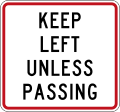
(R7-1) Keep Left Unless Passing

(R7-1) Keep Left Unless Passing

(R7-1) Keep Left Unless Passing

(R7-2) Regulatory sign effective ahead

(R7-2.1) Regulatory sign effective begins

(R7-2.2) Regulatory sign effective ends

(R7-2.1) Regulatory sign effective in 100 metres

(R7-2.2) Regulatory sign effective in 200 metres

(R7-2.3) Regulatory sign effective in 300 metres
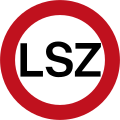
(RG-3) Limited Speed Zone (maximum speed limit of 100 km/h, reduces to 50 km/h during dangerous conditions such as bad weather)

(RP-3.4) Clearway During Prescribed Days

(A40-1) Žádný východ

Old version of No Exit (1960-1987)

(A40-2) Left Turn At Any Time With Care

Old version of Warning Bells At Railway Crossing Turned Off at times prescribed (19??-1987)

(A41-3) Staveniště (to the left)

(A41-3) Staveniště (to the right)

(A41-4) Railway Not In Use

Klouže (1975-1987) (warning of a landslide crossing or undercutting of the road)

(PW-29) Watch for pedestrians crossing

(PW-29.1) Watch for aged pedestrians

(PW-30) Crosswalk ahead

(W16-4/PW-31) Watch for children crossing

(PW-31.1) Kindergarten zone

(PW-32) Škola

(PW-34) Watch for school buses

(PW-34.1) School bus route

(PW-34.2) School bus turning area

(PW-35) Dávejte pozor na cyklisty

(PW-36) Watch for horses

(PW-66) Curve marker with integrated advisory speed 35

(PW-66) Curve marker with integrated advisory speed 35

(PW-66) Curve marker with integrated advisory speed 35

(PW-66) Curve marker with integrated advisory speed 35

(PW-67) Curve marker left

(PW-67) Curve marker right
Combo signs
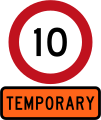
Temporary 10 km/h speed limit
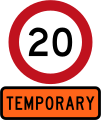
Temporary 20 km/h speed limit

Temporary 30 km/h speed limit
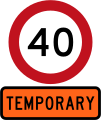
Temporary 40 km/h speed limit

Temporary 50 km/h speed limit
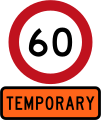
Temporary 60 km/h speed limit

Temporary 70 km/h speed limit

Temporary 80 km/h speed limit

Temporary 10 km/h speed limit

Temporary 20 km/h speed limit

Temporary 30 km/h speed limit

Temporary 40 km/h speed limit

Temporary 50 km/h speed limit

Temporary 60 km/h speed limit

Temporary 70 km/h speed limit

Temporary 80 km/h speed limit

Give way - Straight ahead traffic

Give way - Right turning traffic

Give way - Left turning traffic

Give way to Cyclists

Give way to Cyclists and Pedestrians

Give Way to Oncoming Vehicles (used at traffic bottleneck points)

No Entry - Except Buses (do not enter from this point)

No Entry - Except Cycles (do not enter from this point)

No Entry - Except Authorised Vehicles (do not enter from this point)

No Entry - Except Buses or Cycles (do not enter from this point)

Nezastavovat (on the left of this sign)

Nezastavovat (on the right of this sign)

Nezastavovat (on both sides of this sign)

No Stopping for 1 kilometre

No Stopping for 2 kilometres

No Stopping for 3 kilometres

No Stopping for 4 kilometres

No Stopping for 5 kilometres

No Stopping at times prescribed (on both sides of this sign, includes a late night extension)

No Stopping at times prescribed (on both sides of this sign, includes a late night extension)

No Stopping at times prescribed (on both sides of this sign, includes a late night extension)

Loading Zone Parking: 5 Minutes (goods vehicles only)

Loading Zone Parking: 5 Minutes (on the left of this sign; goods vehicles only)

Loading Zone Parking: 5 Minutes (on the right of this sign; goods vehicles only)

Loading Zone Parking: 5 Minutes (on both sides of this sign; goods vehicles only)

Loading Zone Parking: 5 Minutes (Maximum of 5 minutes to be strictly observed; goods vehicles only)

Loading Zone Parking: 5 Minutes (on the left of this sign; Maximum of 5 minutes to be strictly observed; goods vehicles only)

Loading Zone Parking: 5 Minutes (on the right of this sign; Maximum of 5 minutes to be strictly observed; goods vehicles only)

Loading Zone Parking: 5 Minutes (on both sides of this sign; Maximum of 5 minutes to be strictly observed; goods vehicles only)
Obsolete combo signs

Temporary 10 km/h speed limit

Temporary 20 km/h speed limit
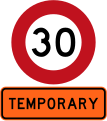
Temporary 30 km/h speed limit
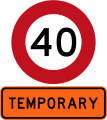
Temporary 40 km/h speed limit

Temporary 50 km/h speed limit

Temporary 60 km/h speed limit

Temporary 70 km/h speed limit

Temporary 80 km/h speed limit

Temporary 10 km/h speed limit

Temporary 20 km/h speed limit

Temporary 30 km/h speed limit

Temporary 40 km/h speed limit

Temporary 50 km/h speed limit

Temporary 60 km/h speed limit

Temporary 70 km/h speed limit

Temporary 80 km/h speed limit

Give Way at Kruhový objezd (give way to vehicles coming from the right)

Give Way at Kruhový objezd (give way to vehicles coming from the right)

Give Way to Oncoming Vehicles (used at traffic bottleneck points)

No Entry - Except Buses (do not enter from this point)

No Entry - Except Cycles (do not enter from this point)

No Entry - Except Authorised Vehicles (do not enter from this point)

No Entry - Except Buses or Cycles (do not enter from this point)

Nezastavovat (on the left of this sign)

Nezastavovat (on the right of this sign)

Nezastavovat (on both sides of this sign)

No Stopping at times prescribed (on both sides of this sign, includes a late night extension)

No Stopping at times prescribed (on both sides of this sign, includes a late night extension)

No Stopping at times prescribed (on both sides of this sign, includes a late night extension)

Loading Zone Parking: 5 Minutes (goods vehicles only)

Loading Zone Parking: 5 Minutes (on the left of this sign; goods vehicles only)

Loading Zone Parking: 5 Minutes (on the right of this sign; goods vehicles only)

Loading Zone Parking: 5 Minutes (on both sides of this sign; goods vehicles only)

Loading Zone Parking: 5 Minutes (Maximum of 5 minutes to be strictly observed; goods vehicles only)

Loading Zone Parking: 5 Minutes (on the left of this sign; Maximum of 5 minutes to be strictly observed; goods vehicles only)

Loading Zone Parking: 5 Minutes (on the right of this sign; Maximum of 5 minutes to be strictly observed; goods vehicles only)

Loading Zone Parking: 5 Minutes (on both sides of this sign; Maximum of 5 minutes to be strictly observed; goods vehicles only)
Location Referencing Management System (LRMS)
The Dopravní agentura NZ (NZTA; Māori: Waka Kotahi) používá a lineární location referencing system for its State Highway network, nationwide.[3] This assists roading contractors, safety auditors and emergency services in pin-pointing locations across the country. The LRMS features several types of signs and methods of reference. All KMP's are installed using a calibrated Trip Meter from the beginning of the road. ERP's however, are placed using land surveying equipment.
All LRMS signs are installed on the 'true left' side of the lane or carriageway, this is determined by the left hand side when facing the increasing direction, The increasing direction of travel is the direction in which positive measurements are made. Divided carriageways (roads with concrete berms or centrelines) have an Increasing (I) side and a Decreasing (D) side. This can be seen on LRMS signs in these areas.
Established Route Position (ERP)
Established Route Position signs are used to highlight a special location or bearing on the highway, These are placed routinely along the carriageways, usually every 3km. They feature the current Reference Station and the number of kilometres from the beginning of that Reference Station. These are required by the NZTA to have an accuracy of less than 3 metres. ERP signs are double-sided and feature a reflective green strip. They also have a small yellow triangle on the post pointing in the roads increasing direction.
Kilometre Marker Post (KMP)
Kilometre Marker Post signs are used to highlight the progression along the highway, These are placed routinely along the carriageways, every 1000 metres. They feature the State Highway Shield, the current Reference Station and the number of kilometres from the beginning of that Reference Station. These are required by the NZTA to have an accuracy of less than 100 metres. KMP signs are on plastic, flexible posts. They are double-sided and feature a reflective black strip.
Reference Station (RS)
Reference Station signs are placed at the change of a Reference Station, or beginning of a Highway. KMP and ERP signs are reset to zero at the beginning of each RS.

ERP Sign (SH1, Route Station 594, 3km)

KMP Sign (SH1, Route Station 594, 1km)

RS Sign (SH1, Route Station 591)
Viz také
Reference
- ^ Traffic Control Devices Manual. Novozélandská dopravní agentura. Citováno 2012-07-15.
- ^ Charlton, S.G.; de Pont, J.J. (2007). Curve Speed Management (PDF). Land Transport New Zealand Research Report 323. Wellington: Land Transport New Zealand. p. 22. ISBN 0-478-28735-6. Citováno 26. září 2013.
- ^ https://www.nzta.govt.nz/assets/resources/location-ref-management-sys-manual/docs/SM051-part-b.pdf New Zealand Transport Agency LRMS Manual SM051 Retrieved 18-03-2019































































































































































































































































































































































































































































































































































































































































































































































































